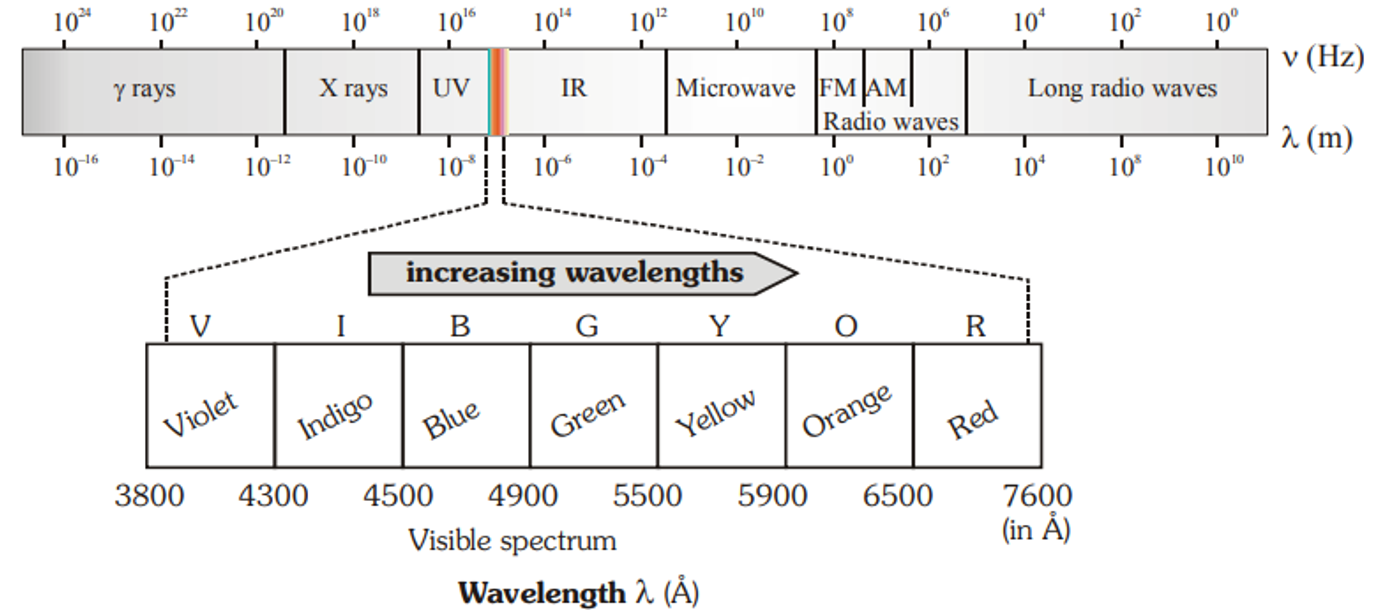

Electromagnetic Spectrum
Electromagnetic Spectrum : Hey there, fellow explorers of science! Have you ever wondered how your TV remote works, or how your smartphone sends and receives signals? The answer lies in something called the electromagnetic spectrum. It might sound like a complicated scientific concept, but it's actually quite simple once you break it down.
Electromagnetic Spectrum
Electromagnetic Spectrum : Let's start our journey by unravelling the mysteries of the electromagnetic spectrum. Imagine a rainbow stretching across the sky, with each colour representing a different type of light. Well, the electromagnetic spectrum is like a super-sized rainbow that includes all types of light, from the ones we can see with our eyes to the ones we can't.
- In short we can say, The arrangement of various types of electromagnetic radiations in the order of their increasing or decreasing wavelength or frequencies is known as electromagnetic spectrum. The wavelength decreases in the following order.
- Radio waves > microwaves > Infrared > Television waves > Visible > Ultraviolet > X-rays > γ rays > cosmic rays

- Each part of the electromagnetic spectrum has its own range of wavelengths and frequencies, but they all travel through space as waves, carrying energy from one place to another. Pretty cool, right?
- In short we can say, The arrangement of various types of electromagnetic radiations in the order of their increasing or decreasing wavelength or frequencies is known as electromagnetic spectrum. The wavelength decreases in the following order.
-
Radio waves > microwaves > Infrared > Television waves > Visible > Ultraviolet > X-rays >
> cosmic rays
- As we discussed, The electromagnetic spectrum is made up of various types of waves, each with its own unique properties. These waves include radio waves, microwaves, infrared waves, visible light, ultraviolet waves, X-rays, and gamma rays. Let's explore some common examples of how we encounter these waves in our daily lives.
Electromagnetic spectrum : Radio Waves
Radio Waves : Radio waves have long wavelengths and are often used for communication. When you tune your radio to your favourite station or use your cellphone to make a call, you're using radio waves to transmit and receive signals.
Electromagnetic spectrum : Microwaves
Microwaves : Microwaves have shorter wavelengths and are commonly used in microwave ovens to cook food quickly and efficiently. They're also used in radar technology, which helps detect the speed of moving objects, like cars on the road.
Electromagnetic spectrum : Infrared Waves
Infrared waves have even shorter wavelengths and are often associated with heat. You can feel the warmth of infrared waves when you stand in the sunlight or use a remote control to operate your TV.
Electromagnetic spectrum : Visible Light
Visible light is the only part of the electromagnetic spectrum that we can see with our eyes. It's what allows us to see colours, shapes, and the world around us. Whether you're admiring a beautiful sunset or reading a book under a lamp, you're experiencing visible light.
Electromagnetic spectrum : Ultraviolet Waves
Ultraviolet waves have shorter wavelengths than visible light and are known for their role in causing sunburns. They're also used in tanning beds and fluorescent lights.
Electromagnetic spectrum : X-rays
X-rays have even shorter wavelengths and are commonly used in medicine to create images of the inside of our bodies. When you get an X-ray at the dentist or the doctor's office, you're being exposed to X-rays to help diagnose any issues.
Electromagnetic spectrum : Gamma Rays
Gamma rays have the shortest wavelengths and are the most energetic waves in the electromagnetic spectrum. They're often used in medical treatments, such as radiation therapy for cancer patients.
“ The electromagnetic spectrum is all around us, playing a crucial role in our daily lives. From the radio waves that allow us to communicate to the X-rays that help us stay healthy, we encounter these waves in various forms every day. By understanding how the electromagnetic spectrum works, we can better appreciate the technology and devices that rely on it to function. So, the next time you use your cellphone or turn on the microwave, remember the invisible waves that make it all possible .”
Solved Example Of Electromagnetic spectrum
Question: How long would it take a radio wave of frequency 6 × 10 3 sec –1 to travel from mars to the earth, a distance of 8 × 10 7 km?
Solution: 2.66 × 10 2 sec
Distance to be travelled from mars to earth
= 8 × 10 7 km = 8 × 10 10 m
Velocity of EM waves = 3 × 10
8
m/sec
Electromagnetic spectrum FAQs
Q.1 : What is the electromagnetic spectrum?
Q,2 : How do we encounter the electromagnetic spectrum in our daily lives?
Q,3 : How does the electromagnetic spectrum impact technology?
Q.4 ; Are there any safety concerns related to the electromagnetic spectrum?
Q,5 : How can understanding the electromagnetic spectrum benefit us?












